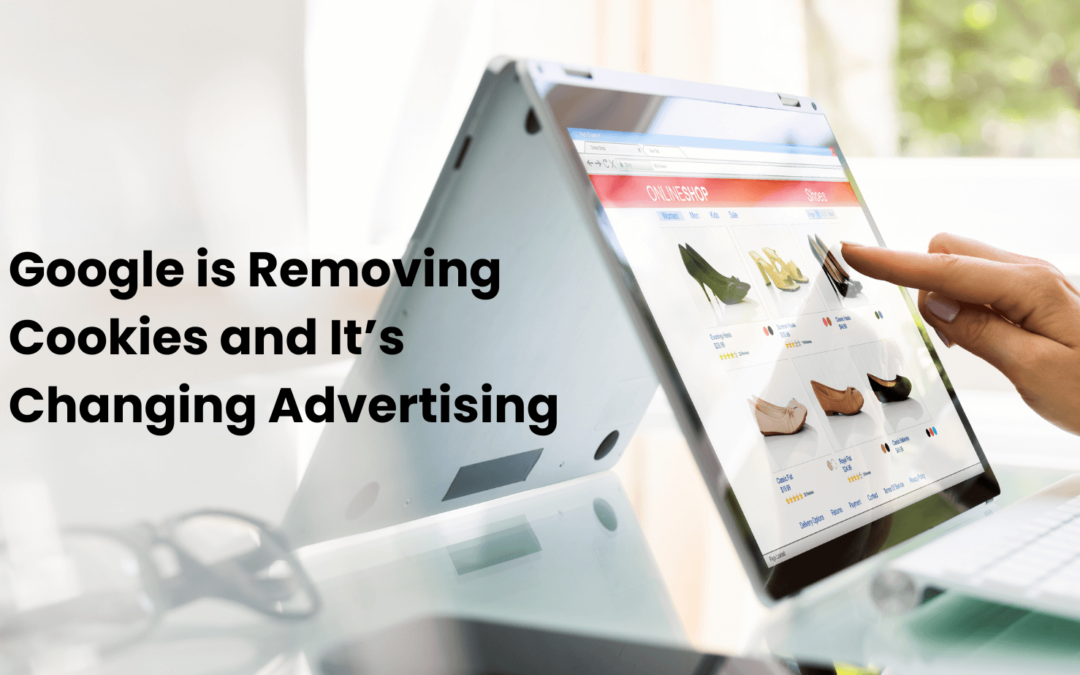
by Ford Saeks | Dec 15, 2023 | Business Success, Internet Marketing, Marketing, Search Engine Optimization, Social Media Marketing, Viral Marketing
Here’s what you need to know:
What’s happening? Google Chrome, the world’s most popular web browser, is gradually phasing out third-party cookies. These cookies are small files that track your online activity across different websites, allowing advertisers to personalize ads and target you based on your browsing habits.
Why is this happening? Privacy concerns have been mounting, with users increasingly uncomfortable with tracking cookies. Governments are also tightening regulations on data privacy, putting pressure on tech giants like Google to adapt.
When is it happening? The phase-out is happening in stages:
- Q1 2024: Google will start testing by disabling third-party cookies for 1% of Chrome users. This pilot phase will allow them to refine their new “Privacy Sandbox” solutions before broader implementation.
- Late 2024: The total phase-out is expected to be complete for all users by the end of 2024.
How will Google removing cookies impact online advertising?
- Targeting: Personalized ads based on third-party cookie data will become less effective. Marketers will need to shift to first-party data collected directly from their own users and contextual targeting based on website content and user engagement.
- Measurement: Tracking conversions and campaign performance will become more challenging. New measurement solutions like Google’s Attribution API will be necessary.
- Reach: Some smaller websites and publishers may see their ad revenue decline as advertisers prioritize reaching audiences through other channels.
Google is not eliminating cookies entirely. First-party and contextual cookies will still be used. On top of that, Google is developing alternative solutions for online advertising that prioritize user privacy, such as Topics API and Federated Learning of Cohorts. You can learn more about this in the Google Privacy Sandbox linked below.
Business owners, marketers, entrepreneurs, or anyone else trying to sell online need to start adapting their strategies now to prepare for the cookie-less future.
But, if you really want to thrive among these changes the best thing you can do is start building your online presence RIGHT NOW. That looks like optimizing your website, enhancing your SEO, start collecting data straight from your customers and clients, and make sure your digital footprint is working for you, not against you. Remember, staying informed and adaptable is key as the digital advertising landscape evolves.
If you want to get the jump on these online changes, start with a free review of your current online presence.
Comment any questions you have and follow us across social media to stay updated on the latest in marketing.
Facebook
Instagram
LinkedIn
TikTok
Youtube

by Ford Saeks | Nov 10, 2023 | Business Growth, Business Success, Copywriting, Internet Marketing, Marketing, Viral Marketing
Boost Your Online Presence by Unlocking the Power of SEO Keywords and Keyword Modifiers
In the modern business landscape, establishing a robust online presence is like setting up your shop in the heart of a bustling marketplace. However, the digital marketplace is vast, and standing out among countless others requires more than just a flashy website design.
This is where Search Engine Optimization (SEO) comes into play.
Your SEO serves as your digital signage and makes sure your business is visible to those who are looking for what you offer.
Understanding SEO
SEO is like the science of digital visibility. It’s a set of strategies used to enhance your website’s ranking on search engines like Google, making it easier for potential customers to find you amid the vast digital marketplace.
The higher your website ranks, the more likely it is for people to visit your site, much like a shop located at a busy intersection is likely to get more foot traffic.
The Heart of SEO: Keywords
At the core of SEO are keywords— the terms or phrases people type into search engines when looking for products, services, or information. Much like a store might be known for selling the “best homemade apple pie in town,” your website can be recognized for specific keywords related to your business.
Remember, these keywords are something that real people are typing out, so don’t overthink it. You don’t want to go overboard either and do what’s called keyword stuffing. Your goal is to weave your keywords into your headlines and messaging seamlessly. Your website should still make sense when a customer reads it.
Where do you add the keywords?
Although search engines, like Google, will ‘crawl’ your entire website, there are places where you should prioritize keyword placement.
- URLs
- Meta Tiles
- Meta Descriptions
- Headings
- The First Paragraph on Each Page
Don’t limit yourself to adding keywords in only these places, but certainly start here.
Adding Spice with Keyword Modifiers: What are keyword modifiers?
Imagine if that store with the best homemade apple pie could be found under “delicious warm apple pie” or “affordable apple pie near me.”
This is where keyword modifiers come into play. They are additional words that make a keyword more specific, targeting a narrower audience or a particular aspect of your business.
Here’s a breakdown of common keyword modifiers categorized by their intent or usage:
| Category |
Keyword Modifiers |
| Transaction |
buy, purchase, order, shop, cheap, deal, discount, sale, bargain, clearance, promo, coupon, affordable, price, preorder, reserve, subscription, membership, registration |
| Information |
how to, guide, tutorial, tips, advice, information, info, facts, techniques, methods, strategies, ideas, examples, lessons, insights, FAQ, instructions, DIY, solutions |
| Local |
near me, in [city name], local, around me, nearby, in [area/region], [city name], [state name], closest, nearest, downtown, suburbs |
| Quality |
best, top, leading, premier, quality, professional, certified, licensed, experienced, superior, deluxe, premium, advanced, reputable, trusted, authentic, high-quality |
| Temporal |
today, now, current, latest, new, recent, updated, modern, contemporary, upcoming, future, seasonal, monthly, yearly, daily |
Problem/
Solution |
fix, repair, solve, troubleshoot, remedy, resolve, prevent, eliminate, alleviate, overcome, address, mitigate, improve, restore |
| Audience |
for beginners, for experts, for [profession], for [industry], for kids, for seniors, for students, for teams, for groups, for companies, for individuals, for professionals |
Product/
Service Type |
online, digital, in-person, virtual, live, custom, personalized, bespoke, professional, commercial, residential, freelance, contractual, temporary, permanent, on-demand |
| Comparative |
vs, versus, compared, alternative, similar to, like, better than, worse than, cheaper than, more efficient than, more effective than |
| Descriptive |
fast, easy, simple, quick, efficient, effective, reliable, dependable, durable, sturdy, flexible, versatile, convenient, user-friendly, practical, functional, sustainable |
Modifiers can be the extra spice that makes your digital presence more flavorful and appealing to your target audience. For instance, a bakery owner might optimize for “affordable custom cakes in [city name]” to attract budget-conscious customers in their area.
Why Small Business Owners Should Care
For small business owners, mastering the basics of SEO and understanding the power of keywords and modifiers can be a game-changer! It’s like having a store in the prime location of the digital marketplace.
Without SEO, your business could be like a hidden gem—valuable but hard to find.
With effective SEO, your digital storefront becomes easily accessible and appealing to a broader audience.
Key Takeaways
- Remember, SEO doesn’t have to be a daunting technical endeavor. It’s about speaking the language your customers are using and meeting them where they are in the digital marketplace.
- By strategically selecting and using keywords and modifiers, you can improve your online visibility, attract more customers, and drive your business success in the digital realm.
- With the right mix of keywords and modifiers, SEO is your ticket to ensuring your small business thrives in the bustling digital marketplace.
Get Started
Don’t let the complexities of SEO hold you back! Start by adding keywords around your most popular product or service and build from there.
If you still feel like you have the knowledge but still aren’t sure where to start, reach out to us! We’ll work together to boost your online visibility, attract more customers, and drive your business forward.
Contact us today or call us at 316-942-1111.
Your potential customers are searching online – let’s ensure they find you effortlessly.

by Ford Saeks | May 12, 2022 | Uncategorized
If you’re not a marketing professional or in the business of promoting yourself or your clients, you may often wonder what it takes to write great copy. Many people who understand the importance of good copy recoil from the idea of having to write it themselves, and for others it comes as naturally as rain. The truth is, everyone already knows how to do it! How? Because you probably already know how to tell stories.
Once you know the proper structure and unlearn some of the stuff your high school teachers taught you about writing, you’ll be well on your way to creating mouth-watering copy.

11 Major Components to Consider for Your Marketing Copy
Pictures attract attention, but text is what sells.
A key component of crafting compelling messages is to make a strong impression. The message is everything. You either paint the picture of the joy the prospect will get using your product, or you paint the view of the hardship he will continue to endure without it. Why? Because people love stories.
To be a great marketing copywriter, understand that you should write as you talk – not formal, dull, perfect English-type speak, but with a clear, conversational style of writing. To get into that zone, imagine your prospect is right in front of you. Then have a conversation with her!
Once you’ve had the conversation, use these 11 Major Components for Your Marketing Copy:
- Kickers – A kicker helps qualify your prospects and gets them to read the headline. It’s like the headline for the headline.
Kickers will intrigue the target market by being enticing and believable. Think of emotion words that would stop a prospect in their tracks.
- Headlines – This is, no doubt, the most critical element.
Did you know that, on average, five times as many people will read a headline as read the content of your copy? Unless your headline sells your product or service, you may have wasted 90% of your money!
- Subheads – Supports the headline and moves the reader to the body copy.
Subheads should hold attention, build on the headline, and compel the reader down the page. They are like a signpost, showing your reader which way to go.
- Benefits and Features – Make a list of your benefits, features, and advantages. It’s vital to attract attention to benefits and then use features to support your claims.
Just speaking in the prospect’s language and focusing on the benefits to him or her is about 80% of compelling copy. Benefits are “emotion or feeling-based” and usually non-tangible; they are the result of what your product or service offers. A benefit answers the question, “What’s in it for me?” If what you are saying is about you, your product, service, or company, then it’s a feature.
- Testimonials – Third-party endorsements help the prospect feel more confident.
There are several types of testimonials you should be gathering, including written reviews, video testimonials, and customer feedback. Also, don’t be afraid to ask a happy customer for feedback. Chances are they will have something great to say that you can show prospects to build confidence in their buying decision.
- Your Offer – What’s your proposition? What problem do you solve, and how can I get it?
Refer back to your target market, the conversation with your prospect, and the core emotion. Elaborate about why your product is precisely what your target market needs or wants. Have you ever had to sell a family member on the reasoning behind a purchase you made? How did you convince them? It started with a conversation…
- Consider Specials, Up-Sells, and Bundles.
People love bundles of products and services because of the increased perception of value. It’s easy to do – just bundle several related products or services together and drop the price below what the total would be if the customer bought all the products separately — using a bonus as an incentive to purchase works great, too. For up-selling, focus your efforts on meeting the customers’ needs, rather than merely pushing more products and services.
- Credibility – Why are you the best choice? Give your customers and prospects reason to believe.
If you make a claim, prove it. To establish a claim that you’ve made, you must tell the truth about your product or service. Don’t use unsubstantiated claims. Instead, use support points to provide more detail. If you lack evidence or proof, you’re going to lack customer conversions.
- Pricing Strategy – Don’t reveal the price until you’ve created the value unless the price is the most compelling reason to act, but it’s better to use other benefits first.
Price isn’t the most effective way to create value. Value comes from the total customer experience. When they are comfortable with your offer, they will be more likely to be more comfortable with the price. So, start by showing them first how valuable your products and services then justify the price after you reveal it.
- Risk-Reversal/Guarantee – Do you have one? Guarantees usually mean more sales.
Chances are, your company has some guarantee, but many companies keep their guarantee a secret for fear that promoting it will cause customers to abuse it. Smart companies know, however, that for every customer that abuses their guarantee, there are hundreds of people who will become customers because they feel secure in knowing that if there is a problem, they’ll be taken care of until satisfied.
- Specific and Measurable Action Step – What do you want the prospect to do, and how should they do it?
Ask for the order – be specific and give an incentive to act now.
Now that you have the major copy components and elements for your marketing material, you’ll be able to spot weaknesses and room for improvements. You may even be better able to notice the flaws in your competitors’ copy and can leverage your marketing to capitalize on their mistakes.
Either way, utilizing this list means you are headed in the right direction with your marketing copy. If you feel like you need more tips and tricks, or maybe your schedule is too full to implement the best marketing practices available, get in contact with us! Prime Concepts Group is here to help you. We’ll do the heavy lifting, so you can get back to enjoying results!

by Ford Saeks | Apr 28, 2022 | Technology, Web Design
I get it. You’re a business and you’re trying to save money by doing your own web design. Consider this:
is that really the best use of your time and resources?
Website design and development is a complex and specialized field, and unless you’re a website expert yourself, chances are you’re not going to create a website that looks or performs as well as one designed by an experienced professional. Hiring a skilled marketing agency is well worth the cost. The results and support you receive will be better than what you would get with a solo attempt.
If you still think you can tackle a website alone, consider the hurdles that you’ll be up against.

- What Will You Do with a Blank Slate?
An empty canvas can be scarier than it looks. It can be exciting to get your hands on a new program or software for web development, but if you loaded it up, would you know what to do with it? If you’re not already a web developer, it takes a lot of time to learn HTML or any other coding language necessary to make a website run.
The quick solution might seem like using a program with a drag and drop website builder, like Wix, that largely eliminates the need to know how to code entirely. It might seem simple on the surface, but the same problem remains. It’s still a brand-new software with a learning curve that will take time to tackle.
A marketing agency already has the knowledge on how to tackle these programs. They’ve mastered the curve and know how to get the most out of the software they use.
- Why Have a Website That’s Not Made for You?
At this point you might be thinking well this drag and drop website creator comes with templates. I can just fill in the blanks and that will take care of the time issue that you just mentioned. Pre-made templates can shave some time for sure, but it’s worth considering who else is using them. You want a website with a design that’s unique to your brand, not a website design that’s used by you, the pet groomers down the street, the barbecue restaurant across town, and even possibly, your direct competitor.
- You Don’t Know What You Don’t Know
SEO, Alt-tags, snippets, schema data…I’ll bet the drag and drop program didn’t mention these! Search Engine Optimization (SEO) is essential for any business today. It helps websites like Google tag your website as relevant in your field and display it toward the top of the search results. A marketing agency will know how to navigate the algorithm to get the search engine recognition you deserve. This is a simple but crucial step that is easy to overlook when creating a website alone.
- What Will Happen When Something Breaks?
It’s inevitable, something will always break on a website. Maybe one morning you wake up and your embedded videos are suddenly not playing, or orders placed on your shopping cart aren’t processing. What will you do? Plugins and programs used to create websites are always updating and sometimes they can change behaviors in ways that not even a marketing agency can predict. What a marketing agency will be able to do is have the professional know how to examine the issue and make the changes necessary to put things back the way they were. This is where a website maintenance service comes in. Website maintenance helps keep your website constantly up to date, running smoothly and securely.
If you only have a base knowledge of website development, it can be difficult to even identify these issues, let alone fix them.
The details of building a website can get far more involved and intricate than this, but for starters these are the big picture concepts to consider when deciding how your business should handle designing a website.
If all these elements are starting to seem overwhelming, reach out to us to discuss which website solutions are best for you! Hiring an experienced marketing agency like us benefits you because you know they can build a functional website that looks great, drives traffic, and captures leads. Prime Concepts provides a great user experience without getting seduced by fancy features that may look cool but end up getting in the way of producing real results.
Contact Prime Concepts for a free marketing critique or to discuss your marketing needs.
Prime Concepts is a creative marketing agency that helps you find, attract, and keep customers through innovative solutions to your most pressing challenges.

by Ford Saeks | Apr 22, 2022 | Social Media Marketing
For the next three months, I want you to concentrate on increasing your organic social media marketing reach. Why? Because quality content accessed in an organic way increases your credibility with your audience.
If you have been working on your brand marketing strategy and getting more serious about creating content for YouTube, Facebook, Snapchat, Instagram, etc., know that organic reach is likely the most accessible form of marketing for your small business.
That doesn’t mean you need to spend bags of money to get big results.
1. The Right Place
Focusing on the material you put out on Facebook, Twitter, Instagram, Snapchat, YouTube, LinkedIn, TikTok, and whatever else has the market’s interest at the time is a significant factor if you are a business or organization who wants to be heard and noticed. The first step is being in the right “place.”
Great social media content is critical for marketing to anyone under the age of 40 right now. This age group learns about your company for the first time by doing one of two things: 1) they search Google, or 2) they find it on social media. Smash those clicks through the roof by focusing on quality material on the most essential social networks.
2. The Right Words
“Subtle Amplification” means that if you concentrate on utilizing the right SEO (search engine optimization, i.e. keywords) at the right time, consistently, you will start being noticed. Using hashtags is an extremely organic approach to improving discoverability and creating amplification for your content, whether you’re a car dealership, an artist, a motivational speaker, or a Fortune 500 firm. If you do happen to have paid media dollars, spending as little as $100 per week on amplification of your YouTube and Facebook content can help that content go viral. The important part is using the right keywords at the right time.
But here’s the thing: no amount of paid advertising will help you turn lousy content into good content. It’s the same reason that no amount of venture capital money will save a terrible product. The long-term success of increasing your brand’s marketing strategy relies on creating strong content, a lot of it, and putting it in the right places with the right words.

No amount of paid advertising is going to turn bad content into good content.
Businesses have been dismissing organic content over the last few years due to the uptick in sponsored advertising. Yes, paid social media has a lot of potential and can be a good deal on advertising (vs. traditional advertising). However, the idea that social media only works if you spend money can result in a lack of hustle and no understanding that outstanding material, especially when amplified in subtle ways, can be extremely successful.
If you’re a small business, try focusing your time, money, and effort on developing excellent content (a lot of it) instead of the other way around. Too many small to medium businesses waste $20,000 a year on PR and paid media when they could have spent a fraction of that on organic social content and a small amplification budget to achieve more valuable results.

3. The Right Approach
This is why organic reach is so important: the feeling a potential customer gets when visiting your website without clicking an ad gives the impression of a more qualified lead and perhaps results in a more valuable and loyal customer.
There are a variety of sponsored strategies (Facebook Ads, Instagram influencer, YouTube pre-rolls, Snapchat ads) that may help you increase your following, but getting serious about the material you put out organically on social media is crucial. Why? Because it is the internet’s most natural and present state. As the supply and demand for paid media gets increasingly crowded, companies who create outstanding content have the (affordable) opportunity to expand in a valuable way.
Prime Concepts Group is a creative marketing agency that helps you find, attract, and keep customers through innovative solutions to your most pressing challenges. We help you create outstanding content for your business. If you discovered this page, it means you have some entrepreneurial blood in your veins. Subscribe to get our articles delivered straight to your inbox and unleash your inner entrepreneur.

 Branding
Branding Strategic Marketing
Strategic Marketing Creative Concepts
Creative Concepts Web Services
Web Services Speaking & Consulting
Speaking & Consulting Website Maintenance
Website Maintenance Careers
Careers Tools We Suggest
Tools We Suggest 10 Tips to Transform Your Marketing
10 Tips to Transform Your Marketing






